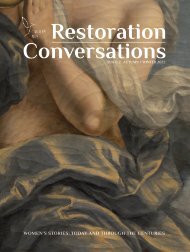Winter 2023
Restoration Conversations is a digital magazine spotlighting the achievements of women in history and today. We produce two issues a year: Spring/Summer and Fall/Winter
Restoration Conversations is a digital magazine spotlighting the achievements of women in history and today. We produce two issues a year: Spring/Summer and Fall/Winter
You also want an ePaper? Increase the reach of your titles
YUMPU automatically turns print PDFs into web optimized ePapers that Google loves.
Elizabeth Wicks. “First, the removal of the thick<br />
layers of oil paint applied by Il Volterrano less<br />
than five decades after the original could put<br />
Artemisia’s delicate glazes just underneath<br />
the over-paint at risk. Second, the veils were<br />
applied by an important late Baroque artist<br />
and are now part of the painting’s history.<br />
Restoration scientists probed the painting at<br />
sixteen depths, nanometer by nanometer. The<br />
reflectograph penetrated the upper drapery,<br />
and we could see Artemisia’s pentimenti –<br />
the places in which she changed her mind. It<br />
took an x-ray to see through the white lead<br />
pigment covering the figure’s thighs – but, in<br />
the end, we got it: a science-based image of<br />
Artemisia’s original.”<br />
Top: Detail during cleaning in UV Fluorescence showing dark repaints on flesh<br />
Above: Installation view of the exhibition<br />
THE REVEAL<br />
Research and chemical analysis allowed<br />
Artemisia UpClose team members to identify<br />
Artemisia’s pigments and painting technique.<br />
Conservators learned, for instance, that she was<br />
sparing with her precious lapis lazuli pigment.<br />
It was more costly than gold at the time, and<br />
Artemisia used very little of it on the parts of the<br />
blue sky which would later be covered by the<br />
architectural framework of the Casa Buonarroti<br />
gallery ceiling. Removal of centuries of grime<br />
and repainting revealed the figure’s navel – not<br />
visible previously – and on the figure’s calf,<br />
Wicks discovered a fingerprint dating back to<br />
the painting’s creation “The fingerprint was<br />
made when the original paint was wet, and it<br />
is highly likely that of Artemisia herself.” Before<br />
completing work on the painted surface, a full<br />
structural conservation of the painting was<br />
carried out.<br />
Because the painting has been displayed<br />
‘belly-down’ on the ceiling since its creation<br />
50 Restoration Conversations • <strong>Winter</strong> <strong>2023</strong>





